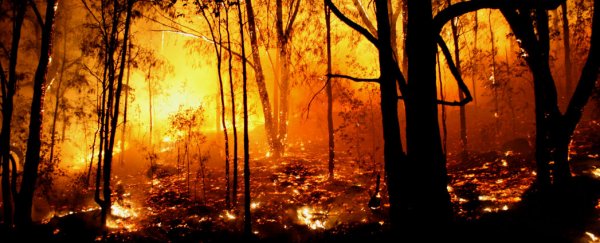Thanks to the forest that now covers much of the exclusion zone around Chernobyl, significant amounts of radioactive contamination has been locked into the area. And now researchers say there's a real risk that it will be released by wildfires, and spread hundreds to thousands of kilometres across Europe.
In April 1986, a disaster at the Chernobyl Nuclear Power Plant in Ukraine saw one of its nuclear reactors explode due to faulty design and operation. Thirty-six hours after the explosion, officials started evacuating the Chernobyl residents, and by 1990, more than 350,000 people had been relocated away from the most highly contaminated areas of Belarus, Russia, and Ukraine.
What remains from the explosion is a 2,600-km2 area - known as the Chernobyl Exclusion Zone. It's now completely devoid of humans, but large amounts of radioactive contaminants remain. A second exclusion zone lies north of the Ukraine border, where Belarusian officials have sectioned off another 2,200-km2 area. Within these zones are vast areas of farmland and dense forests, both of which were exposed to the heavy clouds of radioactive fallout at the time of the explosion.
A clean-up crew was sent in to cut down all the trees within a 4-km radius of the power plant and bury them, and it's thought that most of the contamination - including radioactive isotopes Caesium-137 and strontium-90, multiple isotopes of plutonium, and other radionuclides - sank into the rivers and soil.
Now, with the zones and their wildlife being left well alone for almost three decades, the forest that once covered 53 percent of the area currently spreads across more than 70 percent of it, moving steadily into the abandoned fields and pastures. Which sounds like great news, but because of the way these trees interact with the contaminants, they're actually keeping them around, rather than letting them be washed or eroded away, researchers have found:
"As trees, grasses, other plants, and fungi transpire (release water), they draw water up from the roots. Water-soluble salts of caesium and strontium are chemical analogues of potassium and calcium, respectively, and are taken up in place of these crucial nutrients. The leaves fall to the ground in autumn, becoming part of the 'litter' (the abscised vegetation that covers the forest floor), thus returning the radioactive salts to the top layer of the soil."
So the trees keep cycling the radioactive contaminants through the soil, never letting them dissipate. Previous research has shown that large amounts of the strontium-90 isotope left over from the 1986 explosion have been caught within the top 10 cm of the soil, and the Caesium-137 isotope is lurking in even shallower ground - the top 5 cm of the soil. And all it would take to disturb these contaminated layers is wildfire sweeping through and clearing out the trees to expose the forest floor to the wind and the rain.
To figure out what the wildfire risk is in this area, a team led by Nikolaos Evangeliou from the Norwegian Institute for Air Research used remote-sensing data and observations of previous fires that tore through the place in 2002, 2008 and 2010, and took new measurements of the contamination levels in the forest. They then ran everything through several programs that modelled wind, air, and wildfire movements.
"They estimate that of the 85 petabecquerels (PBq) of radioactive caesium released by the Chernobyl accident, between 2 and 8 PBq still lurk in the upper layer of soil in the exclusion zone," says Debora MacKenzie at New Scientist. "The team calculates that the three fires released from 2 to 8 percent of the caesium, some 0.5 PBq, in smoke. This was distributed over eastern Europe, and detected as far south as Turkey and as far west as Italy and Scandinavia."
While the amount of radiation predicted to be spread by a future wildlife is tiny - about 1 percent of the annual dosage a human can handle without causing health issues - it's no reason for the threat to be ignored, the researchers point out.
"The average dose isn't the problem," says MacZenkie at New Scientist. "Some people will get much more, as fires dump radioactive strontium, plutonium and americium as well as caesium unevenly, and as some foods concentrate these heavy metals - for example, caesium in mushrooms."
"The internal dose from ingestion can be significant," one of the team, Tim Mousseau from the University of South Carolina in the US, told her. "The resulting cancers might be hard to spot among many other less-exposed people. But they will be very significant for those who experience them."
And the risk of wildfires here is only going to get worse, with larger and more frequent events predicted worldwide, due to climate change drying out the forests and increasing the instances of fire danger weather. What makes things even worse for the Chernobyl forest is that no one's going in there (for obvious reasons) to clean up all the dead trees and foliage that make very effective fire fuel. Plus the area has a severely understaffed fire brigade, and because the radiation in the soil is killing off the insects and microscopic organisms that help break down the leaf litter, the dead vegetation is now buiding up at twice the rate it was before 1986. "We brought in litter from an uncontaminated zone and found it decayed only half as fast," Evangeliou told New Scientist.
Publishing in the journal Ecological Monographs, team predicts that the most risky years for wildfires will be between 2023 and 2036, but by 2060, everything should be okay, the radiation will have finally decayed.
Here's some drone footage of what the place looks like now, right around the power plant:
Source: New Scientist
